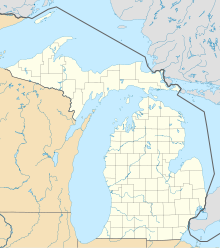Adrian (Michigan)
| Adrian | ||
|---|---|---|
| Nickname : Maple City | ||
 |
||
| Location in Michigan | ||
|
|
||
| Basic data | ||
| Foundation : | 1826 | |
| State : | United States | |
| State : | Michigan | |
| County : | Lenawee County | |
| Coordinates : | 41 ° 54 ′ N , 84 ° 2 ′ W | |
| Time zone : | Eastern ( UTC − 5 / −4 ) | |
| Residents : | 21,574 (as of: 2000) | |
| Population density : | 1,172.5 inhabitants per km 2 | |
| Area : | 18-9 km 2 (about 3 mi 2 ) of which 18.4 km 2 (about 7 mi 2 ) is land |
|
| Height : | 240 m | |
| Postal code : | 49221 | |
| Area code : | +1 517 | |
| FIPS : | 26-00440 | |
| GNIS ID : | 0619846 | |
| Website : | www.ci.adrian.mi.us | |
| Mayor : | Gary McDowell | |
Adrian is a city in the US state of Michigan and the county seat of Lenawee County . At the 2010 census , the population was 21,133.
location
Adrian is located approximately 30 miles southwest of Ann Arbor , 30 miles southeast of Jackson, and 30 miles northwest of Toledo . Part of the city lies on the border between Adrian Township and Madison Charter Township, but is politically independent of both. The urban area extends beyond the city limits in these two parishes as well as in the Raisin Township and the Palmyra Township. Adrian is sometimes called "Maple City" because of the many sugar and other maple trees in the city. The Adrian High School sports teams are known as the Adrian Maples and several local businesses use the Maple name on their behalf.
geography
According to the United States Census Bureau , the city has a total area of 18.9 km 2 of which 18.4 km 2 is land and 0.5 km 2 is water. The city is about 15 miles southeast of the Irish Hills, an area known for its many lakes and rolling hills. The area used as a recreational area by the city's residents.
history
Adrian was founded on June 18, 1826 by Addison Comstock, a sponsor of the Erie and Kalamazoo Railroad, and was originally named Logan. The city was renamed Adrian in 1828 by Addison's wife, after the Roman Emperor Hadrian .
Early industrialization
In the late 19th century to early 20th century Adrian was known as the "fence capital of the world" when J. Wallace-Page invented the first commercially successful wire fence. During this time Adrian was the first manufacturer of wire fences and the fences were shipped far, for example to New York, Berlin, Asia and Africa. The company sponsored the very successful baseball team Page Fence Giants.
The automotive industry settled between 1900 and 1912. One of the first vehicles, the Lion Automobile, was built in Adrian. Three manufacturers were based in Adrian. All three companies ran into financial difficulties and had to close.
Demographic data
According to the 2000 census, 21,574 people lived in 7,908 households and 4,855 families in the city. The population density was 1,166.6 per km 2 . There were 8,498 housing units at an average density of 459.5 per km 2 . There were 7,908 households in which in 31.7% of the cases children under 18 years of age. In 40.8% of the cases they lived together as married couples, 15.9% had a female head of the household without a husband, and 38.6% were not families. 31.5% of all households were made up of individuals and 12.9% had people who were 65 years of age or older. The average household size was 2.45 and the average family size was 3.09.
In the city, 25.3% of the population were under 18 years old, 15.4% were aged 18 to 24, 25.5% were 25 to 44 years old, 19.0% were 45 to 64 years old and 14 , 8% were 65 years of age or older. The median age was 32 years. For every 100 women there were 87.0 men.
The median income for a household in the city was $ 32,405, and the median income for a family was $ 42,069. Males had a median income of $ 31,500 versus $ 23,359 for women. The per capita income for the city was $ 16,528. Over 9.8% of families and 13.8% of the population were below the poverty line , including 15.5% under 18 years of age and 19.8% 65 years of age or older.
sons and daughters of the town
- Muriel Stafford (1906–2004), Canadian organist, choir director and music teacher
Individual evidence
- ↑ Laws of the territory of Michigan , Volume 3. WS George & Co., Lansing, Michigan 1874, pp. 1392-1397.

